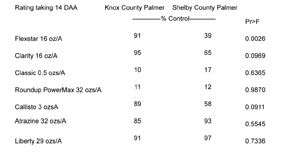Recent Midsouth Studies Show Dicamba Not Very Effective On Some Populations Of Glyphosate/PPO-Resistant Palmer Amaranth
DR. LARRY STECKEL
JACKSON, TENN.
Last summer Dr. Tom Barber, University of Arkansas weed scientist, invited me to visit his field research on glyphosate/PPO-resistant Palmer amaranth in Crittenden County, Arkansas. As was expected glyphosate and Flexstar provided very poor Palmer amaranth control in his tests.
What was not expected is that a number of other herbicides provided poor control as well. Even dicamba at 0.5 lbs/A (Clarity 16 oz) on small Palmer amaranth provided less than optimal control. The only herbicides that still appeared to work in those trials were atrazine and Liberty. Until I had visited those Arkansas locations I had not seen dicamba on small Palmer amaranth perform that poorly. It was concerning to say the least and as a result we decided to screen Palmer amaranth on the Tennessee side of the river also.
We sent Palmer amaranth that we were confident was glyphosate/PPO resistant from north Shelby County, Tennessee to my colleague Dr. Tom Mueller in Knoxville last fall. He had a graduate student, Alinna Umphres, that subsequently screened this Palmer amaranth for its tolerance to a number of herbicides applied POST. As a check, the researchers also screened Palmer amaranth sourced from Knox County that was known to be resistant to glyphosate but not to PPO herbicides. The herbicides chosen to screen were then applied to the Palmer when it was 4” tall.
The results are below. In short, the Shelby County Palmer amaranth population, as expected, was resistant to glyphosate, Flexstar and Classic. Unfortunately, just like in Crittenden County, the Palmer amaranth also showed tolerance to dicamba and mesotrione. Moreover, just like the research in Arkansas the Palmer amaranth was still readily controlled by atrazine and Liberty.
In the table below the average control for each herbicide by population is compared. The column to the far right labeled Pr>F gives a number for each comparison. The smaller that number the higher the probability that there is a real difference between the populations for that herbicide. This number is important for this type of comparison as the populations are not pure. For example with Clarity about 2/3 of the plants screened for Shelby county were controlled less than 60 percent (a number showed <5 percent control) while 1/3 of the population was controlled 100 percent. In contrast, all the Knox county pigweed plants were controlled better than 92 percent 14 days after application.
So what is going on? It is known that the PPO-resistance in our Shelby County population has at least 3 different genes for resistance to PPOs. However, we are still finding Palmer amaranth that is resistant to PPO herbicides but does not contain any of those genes. A possible reason is a 4th resistance mechanism is metabolism-based where the plant is producing enzymes that tie up the PPO herbicides. These enzymes can also tie up other herbicides as well. Last year’s field data from Arkansas and now this greenhouse data from Tennessee would suggest that metabolism could very well be an issue for at least some of our PPO-resistant Palmer amaranth in the Midsouth.
So what does this mean for us? This spring in some areas like Crittenden County in Arkansas and Shelby and Tipton Counties in Tennessee there is a good chance that some Palmer amaranth will escape Engenia or Xtendimax applications. Therefore scouting will be critical. Do not assume because Engenia or Xtendimax have been sprayed on Palmer amaranth that they will all be controlled. Have eyes on the field that confirm they are controlled.
So what do we do? Diversity is still the key. PRE applied herbicides containing a good residual for control of Palmer amaranth must be used. Then overlap a POST emergence that has good residual activity on pigweed prior to the PRE playing out, even in Xtend and LL crops. Moreover, cultural methods such as narrow soybean row widths, hand weeding and cover crops will need to be used now more than ever.
Finally should we kick to the curb the herbicides that have such resistance issues? I do not think so for two reasons. First if we no longer utilize herbicides that have resistance issues we have almost none to choose from. Second, even with ones like fomesafen that will miss a lot of Palmer amaranth POST, they still provide a lot of weed control help applied PRE. They just can no longer be applied alone but tankmixed with another good residual herbicide for pigweed like metribuzin, Dual Magnum, Zidua, etc. ∆
DR. LARRY STECKEL: Extension Weed Specialist, University of Tennessee
